Return to beginning.
It was not possible to predict the long-term consequences of Azolla in Nature Conservancy marshes at that time. On the beneficial side, Azolla is considered a good food source for waterfowl and provides cover for small invertebrates, which could enhance the value of these marshes for migrating waterfowl. On the other hand, Azolla spreads rapidly by vegetative reproduction and may form extensive mats. It should never be introduced intentionally, as it quickly may overspread a water body and become quite a nuissance.

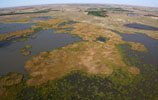

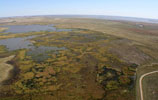
|
Return to beginning.
 |
| Panoramic image looking to northeast at center, east toward right, north toward left. Assembled from two wide-angle shots. |
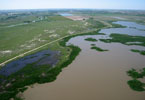 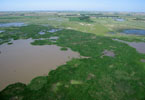 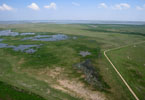 |
![]()
![]() Return to beginning.
Return to beginning.
Continue to 2012 – 2013.
Return to Cheyenne Bottoms homepage.
All rights reserved © (2020).